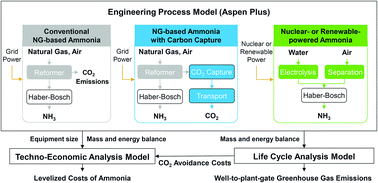Techno-economic performances and life cycle greenhouse gas emissions of various ammonia production pathways including conventional, carbon-capturing, nuclear-powered, and renewable production†
Abstract
Ammonia (NH3) is conventionally produced using fossil natural gas (NG) for hydrogen production through steam reformation and synthesis in the Haber–Bosch (HB) process. The global conventional ammonia production contributes more than 420 million tons of CO2 emissions annually. In this work, we investigated the techno-economics and well-to-plant-gate (WTG) greenhouse gas (GHG) emissions of conventional NG-based, carbon-capturing, nuclear-powered, and renewable ammonia production by developing an engineering process model for each. Carbon-capturing ammonia production refers to the NG-based ammonia production while capturing CO2 and transporting it via pipelines for storage or utilization. Nuclear-powered and renewable ammonia production represents an alternative ammonia production through water electrolysis, air separation, and the HB process using carbon-free energy sources. Nuclear and renewable energy sources are assumed to be used for nuclear-powered and renewable ammonia production, respectively. Sensitivity analyses are performed for CO2 pipeline transport distances, potential carbon capture tax credits, and clean H2 production cost. Carbon-capturing ammonia production reduces WTG GHG emissions by 55–70% compared to conventional NG-based ammonia production methods. Nuclear-powered and renewable ammonia production almost eliminate GHG emissions since energy supply is either zero carbon or near-zero carbon. However, when $4.16–4.83 per kg is the cost assumed for clean H2 production using state-of-the-art electrolysis technologies, the levelized costs of nuclear-powered and renewable ammonia are calculated to be $0.92–1.06 per kg NH3, which are approximately four times higher than the conventional NG-based ammonia production cost. The cost of CO2 emission avoidance is estimated in the range of $266–318 per metric ton of CO2 for nuclear-powered and renewable ammonia production. The clean H2 production cost is the major contributor to the levelized costs of nuclear-powered and renewable ammonia production. A lower production cost, near $1 per kg H2, for clean H2 is required for nuclear-powered and renewable ammonia production to be cost-competitive with conventional NG-based ammonia production.

- This article is part of the themed collections: Measuring Green Chemistry: Methods, Models, and Metrics and 2022 Green Chemistry Hot Articles


 Please wait while we load your content...
Please wait while we load your content...